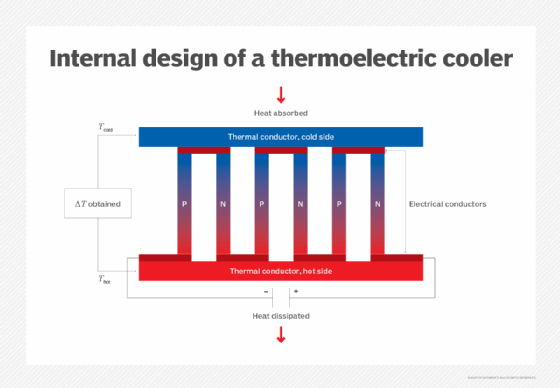
Gorodenkoff - stock.adobe.com
Is TEC the next data center cooling breakthrough?
Thermoelectric cooling uses semiconductors for efficient temperature control of IT equipment, while using less energy, but it has limitations in ambient cooling and scalability.
Thermoelectric cooling is an innovative technology that harnesses the principles of thermoelectricity to efficiently manage temperature control in various applications, from consumer products to critical IT equipment.
As traditional data center cooling methods face efficiency and environmental impact challenges, TEC presents a possible alternative. It offers precise temperature regulation and has the potential to use less electricity. This article explores how TEC's application works, its advantages and its potential role in the future of data center cooling.
How does TEC work?
When a direct current passes through two different metals, such as copper and zinc, sandwiched together, a temperature change occurs at the junction of the two metals. TEC devices are either warm or cool depending on the direction of the current flow. If the number of junctions is multiplied and connected in series, the cooling or heating capacity multiplies proportionally.
Modern TEC devices use small p-type and n-type semiconductors, enabling many junctions in a small space. However, there is currently a practical limit to the number of junctions that can be assembled before the manufacturing cost becomes prohibitive and power usage approaches that of conventional cooling.
TEC devices affect cooling in two ways. First, they transfer heat from its source to the other side of the TEC device, where they capture and reuse it elsewhere or transfer it to the atmosphere using liquid or air. TEC devices also provide active cooling to the device, offering efficient temperature control. For example, a 200-watt (682 British thermal units per hour) device, operating at a coefficient of performance of 4 and a 10-degree Celsius (18-degree Fahrenheit) temperature differential, or ΔT, could transfer 150 W (511 BTU per hour) of heat away from the heat source and simultaneously introduce 50 W (170 BTU per hour) of actual cooling.
Three factors determine TEC capacity: the number of semiconductor junctions, the ΔT between the hot and cool sides of the TEC device, and the environmental ambient temperature. A higher ΔT between the hot side and cold side of the TEC device yields more capacity, while higher ambient temperatures reduce capacity.
IT applications of TEC devices are primarily to maintain the critical temperatures of laser diode launch devices for high-speed, long-reach optical fiber. TEC devices are being investigated for more IT industry uses due to their small size, potentially low energy use, noise-free operation and long performance.
Note: TEC only cools. Humidity must be controlled by more conventional means, like an HVAC system.

Advantages of TEC devices
- Efficiency. Most applications consume less electricity than compressor-based cooling systems when designed properly.
- No refrigerant. There is no risk of greenhouse gas emissions leaking, and these systems will not be phased out for environmental reasons.
- Temperature control. TEC devices provide accurate temperature control within 0.01 degrees Celsius (32 degrees Fahrenheit), which is significantly better than compressor-based cooling and is essential for certain IT applications.
- Quick adjustment. These systems can rapidly adjust to meet actual cooling needs, further minimizing energy consumption.
- Compact size. TEC devices are small enough to fit into spaces where even liquid cooling loops cannot.
- Two-pronged cooling system. TEC devices effectively transfer heat away from the source, while delivering actual cooling.
- Potential energy generation. The temperature difference across a thermoelectric device can generate electricity.
Disadvantages of TEC devices
- Ambient temperature-dependent. TEC cannot cool below the environmental temperature, which can limit outdoor and direct sun applications. However, the cold side can still reach below ambient in many settings. This is not a concern in data centers since most operate close to the ASHRAE-recommended temperature limit of 27 degrees Celsius (80.6 degrees Fahrenheit). Still, it can be a factor in external long-distance optical networks.
- Temperature differential-dependent. TEC capacity increases as the temperature differential decreases, which is the opposite of cooling coils. Maximum heat removal tends to occur with a temperature change of 10 degrees Celsius (50 degrees Fahrenheit), but heat reductions of 60 degrees Celsius (140 degrees Fahrenheit) commonly occur in practice where heat loads are relatively low.
- Heat challenges. Current TEC devices perform best in cooling applications between 200 W (682 BTU per hour) and 300 W (1,023 BTU per hour), with some models achieving up to 1,600 W (5,459 BTU per hour) under ideal conditions. But they struggle to meet the heat removal needs of standard high-capacity racks. Non-data center designs have reached 150 kW (511,821 BTU per hour), but standard applications are still far below the capacity of today's racks, which range from 5 kW (17,060 BTU per hour) to 40 kW (136,485 BTU per hour) or more. Most source heat transfers to the other side of the TEC device, so it must still discharge to the atmosphere by either air or liquid.
- Limited scalability. TEC has scalability limitations, as larger devices become expensive and may consume more power than traditional compressor-based cooling systems.
Applications of TEC
- TEC packages are small and can be configured to meet the physical constraints of applications.
Devices in the order of 3x3 millimeters are common. - TEC devices are used in many high-speed fiber optic switches.
- TEC devices are also used in high-power, long-reach fiber laser diodes where heat removal and accurate temperature control are critical to maintaining wavelength and transmission distance.
- TEC devices are becoming critical to 400 Gb and 800 Gb communication devices, which require extreme temperature stability and cooling.
- TEC devices are helpful where there is concern about liquid flowing through devices.
- TEC use in processors is presently limited but is likely to increase as maintaining junction temperatures in high-performance CPUs becomes more difficult.
TEC research
Reports showed systems coupling multiple TEC and thermoelectric devices with heat pipes, generating electricity from the CPU heat to offset some of the processor energy load.
Researchers at the Central Universities of China reported achieving partial power usage effectiveness of less than 1.0 in laboratory trials, which was formerly thought impossible. However, this is not yet commercially viable.
Mechanical engineering students at the University of Illinois reported a system design to cool a rack and power server from waste heat. However, the work is theoretical. No prototype was built, so data is unavailable.
With further advancement, TEC devices might work for entire cabinets one day. However, since TEC devices do not yet scale economically to large sizes, full-rack TEC does not appear to be imminent. Controlling processor junction temperatures in high-performance servers could be on the horizon, but applications for full-rack cooling are still years away, if ever.
Robert McFarlane is senior principal in charge of data center design for the international consulting firm Shen Milsom and Wilke LLC. McFarlane has spent more than 40 years in communications consulting and has experience in every segment of the data center industry.







